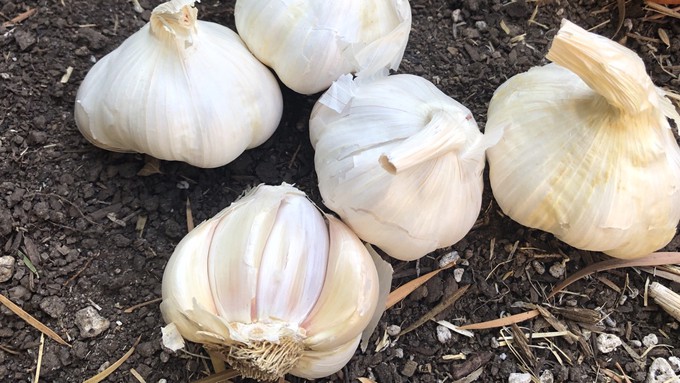
Keeping pests away, the stinky plant makes a great companion to other vegetables

Garlic is a natural pest deterrent as well as a culinary delight. Kathy Morrison
Get a head start on a more flavorful 2023 – and protection for your vegetable garden from pesky pests. Plant garlic this fall and enjoy its many (fragrant) benefits.
Garlic is now available from such mail-order seed companies as Peaceful Valley Farm and Garden Supply in Grass Valley as well as local nurseries. It can be planted from October through December for harvest next summer, though earlier is better.
Garlic ranks as the most popular vegetable to plant among American gardeners, according to recent surveys. Why? We eat a lot of it, on average 2.5 pounds per person each year.
California, which produces most of the nation’s garlic supply, has an ideal climate for this onion cousin. According to UC Davis research, the best varieties to grow in the Sacramento area are “softneck” or silver skin garlics. They put all their energy into producing fat bulbs underground and rarely bolt. The most popular softneck varieties for our climate: California Early and California Late.
“Hardneck” varieties, also called “top-setting garlic,” also grow well in our area. Hardnecks produce a strong stem or scape, which is a spring vegetable all its own. These varieties often have purple or red skins and evocative names such as Purple Italian, Russian Red and Spanish Roja.
In addition to its culinary assets, garlic is a natural pest deterrent. Its scent keeps a wide range of pests away from neighboring plants including codling moths, spider mites, aphids, ants and snails as well as several species of gnats and flies.
Deer and rabbits don’t like garlic either. Planted along the borders of a garden, garlic can form a scent barrier to hungry critters. Garlic builds up sulfur content in the soil, acting as a natural fungicide. But not all vegetables like this extra dose of sulfur. Avoid planting garlic near peas, beans, asparagus, parsley or sage. (It will actually stunt their growth.)
And even though it's a close cousin to onions, garlic shouldn’t be planted in the same spot where onions have grown in the past two or three years; it can pick up diseases or other issues.
For the best crop, garlic needs full sun and good drainage, but not much room or water.
When planting, break the head apart into separate cloves, each with a little bit of the “foot” attached where they were connected. Plant pointy end up, about 2 inches deep. Garlic can be planted only 3 or 4 inches apart. Water once when freshly planted, then let the cloves rest. After they sprout, they need weekly irrigation if there’s no rain.
Baby garlic plants don’t like competition; remove any weeds that try to crowd them out.
For more tips on growing garlic: https://vric.ucdavis.edu/veg_info_crop/garlic.htm
Comments
0 comments have been posted.Sacramento Digs Gardening to your inbox.
Sites We Like
Garden Checklist for week of May 5
Survey your garden after the May 4 rainstorm. Heavy rain and gusty winds can break the neck of large flowers such as roses. Also:
* Keep an eye on new transplants or seedlings; they could take a pounding from the rain.
* Watch out for powdery mildew. Warmth following moist conditions can cause this fungal disease to “bloom,” too. If you see a leaf that looks like it’s dusted with powdered sugar, snip it off.
* After the storm, start setting out tomato transplants, but wait on the peppers and eggplants (they want warmer nights). Pinch off any flowers on new transplants to make them concentrate on establishing roots instead of setting premature fruit.
* Trim dead flowers but not leaves from spring-flowering bulbs such as daffodils and tulips. Those leaves gather energy to create next year's flowers. Also, give the bulbs a fertilizer boost after bloom.
* Pinch chrysanthemums back to 12 inches for fall flowers. Cut old stems to the ground.
* Mulch around plants to conserve moisture and control weeds.
* From seed, plant beans, beets, cantaloupes, carrots, corn, cucumbers, melons, pumpkins, radishes and squash.
* Plant onion sets.
* In the flower garden, plant seeds for asters, cosmos, celosia, marigolds, salvia, sunflowers and zinnias. Transplant petunias, zinnias, geraniums and other summer bloomers.
* Plant perennials and dahlia tubers for summer bloom.
* Don’t wait; plant summer bulbs, such as gladiolus and tuberous begonias.
* Harvest cabbage, lettuce, peas and green onions.